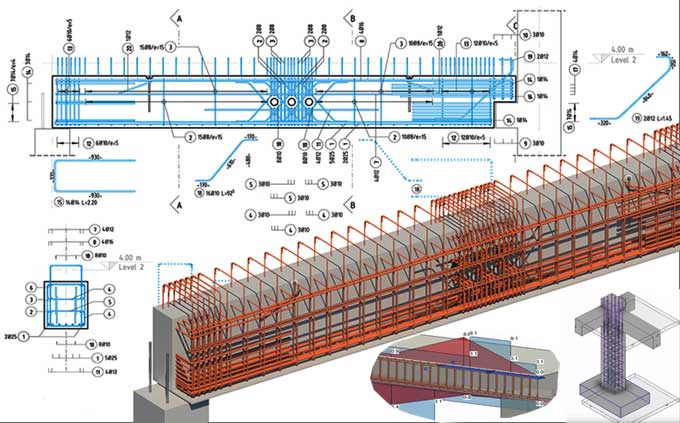The BIM Process for Structural Engineers: The ability to detail Concrete designs in one model
Tweet
Coordination between the design intent and detailed models has always been a very hectic issue. BIM enables seamless transitions from the design to the detailed model while still following local codes and automating changes so they aren't disruptive to the design process.
Structure engineers typically use different software from other project stakeholders. Many companies have been using tools to import and export files between their software programs. But you feel simplicity and precision should factor for coordinating and ultimately result in reliable behavior for any structure throughout its lifecycle.
Precast concrete walls are a good example. These walls have specific dimensions based on the position in the building. Engineers and architects specify segmentation, and structural engineers specify the reinforcement.
Structural Analysis of Revit Model
Let's imagine the architect sends us a conceptual design. The structural engineer comes up with a mathematical model and a structure. To perform structural analysis, Revit offers multiple tools for developing the analytical model and editing it. The model can export to other analysis software you can use along with Revit. The results can import into Revit to evaluate the impacts of various design changes.
Rebar definition can now begin with the results available in the Revit model. AMER and EMEA follow different approaches to this process. Structure engineers start by analyzing the efforts and proposing reinforcement patterns, a practice generally encountered.
A structural engineer can refer to the concrete elements and reinforcement patterns on a plan and a scaled model using engineering schedules or place tags. The structural analysis allows the determination of rebar more directly and in compliance with local codes, which is a method that is commonly employed in Europe.
It is the beauty of Revit that it allows both approaches. All structural engineers can work within a BIM environment connected to architects, mechanical, electrical, and plumbing engineers, & the extended project team.
Code Driven Automatic Generation of Reinforcement
The BIM model includes results packages that can generate Reinforcement automatically in code design tools. There are numerous ways to reinforce concrete elements according to engineering standards from various countries and regions.
SOFISTIK Reinforcement Generation (RCG)
A 3-D object creates for every concrete beam, column, floor, wall, or slab based on the inputs of the SOFISTIK Reinforcement Generation software. It develops to meet the required reinforcement criteria, the Reinforcement based on the defined rules.
Controlling the rules files allows users to respect the standards of various countries or companies. Afterward, Reinforcements can update manually. RCG offers real-time checking of the Reinforcement directly in Revit 3D views. The required and existing Reinforcement in a framing element can compare using the Check command.
If the Reinforcement adjusts, the diagrams react instantly, giving precise feedback to the engineer about how to optimize the reinforcement patterns.
This command performs a comparison between the existing reinforcement in surface elements and the required reinforcement in user-defined sections.
Detailing can begin after the rebar has been modeled. As part of the SOFISTIK Reinforcement Detailing tool, the bar-bending schedules and shop drawings can comply with the same standards across this phase of the project.
Graitec Reinforced Concrete BIM Designers
Utilizing Revit results in packages, users can generate reinforced beams, columns, and isolated foundations made of single-span and continuous concrete by using this tool.
There are various options for specifying the bar diameters and the number of bars in concrete elements. Dedicated features of the tool allow for generating shop drawings and bar bending schedules, based on predefined templates.
It also computes rebar cages based on the theoretical reinforcement envelope for a group of identical elements simultaneously. A reinforcement cage template can also save that is reusable for similar elements. So they can adapt to their new hosts based on predefined rules.
This tool generates engineering design reports. User-defined design reports are based on country-specific templates and are customizable. A comprehensive design report includes the theoretical formulas and values utilized in the calculation. It also includes the results and work ratios for each verification.
CADS RC3D
Rebar can place, annotate, and mark in 3D structures with this tool. This software allows you to create drawings with 2D details and lists of bar bending according to national standards. Some features of the program include:
- Marking rebar ends and detailing tapered ranges through annotation.
- Split rebar into zones within a structure using enhanced layering tools.
- Copying rebar between structures using editing functions.
- Placement of rebar in parallel through the structure is achieved using path placement.
- Controlling the rebar in accordance with the given structure, release, and drawing sheet.
- Lists of custom rebar.
To get online demonstration, watch the following video tutorial.
Video Source: Graitec Group
Final Thoughts
Because many reviews take place during the design phase, concrete elements are likely to change geometry.
It automatically does the necessary adjustments since Revit restricts its reinforcement to concrete without requiring the user to alter it manually. It is possible to model the rebar in its details and in sync with the concrete structure, which allows the fabrication team to fabricate and install the model for error-free clash-free installation.
Structures analysis results, rebar models, engineering designs, bending details, bar schedules, and shop drawings must always be current and coordinated to ensure successful project delivery.

Gallery
Feel free to contact us for BIM requirements. One of our representative will respond you within 24 Hours. Send us your projects requirement today and grow your project.
Explore More !







